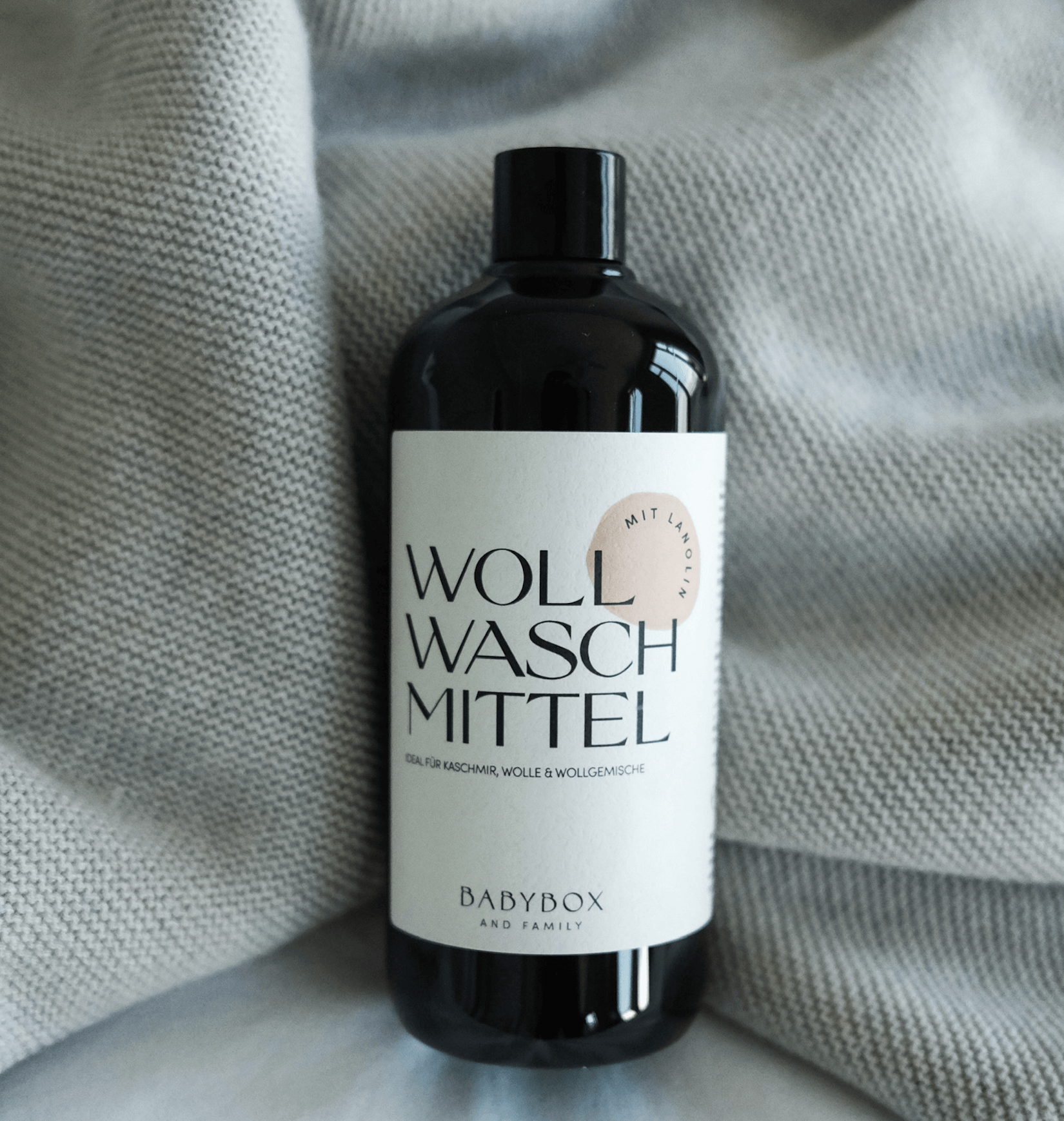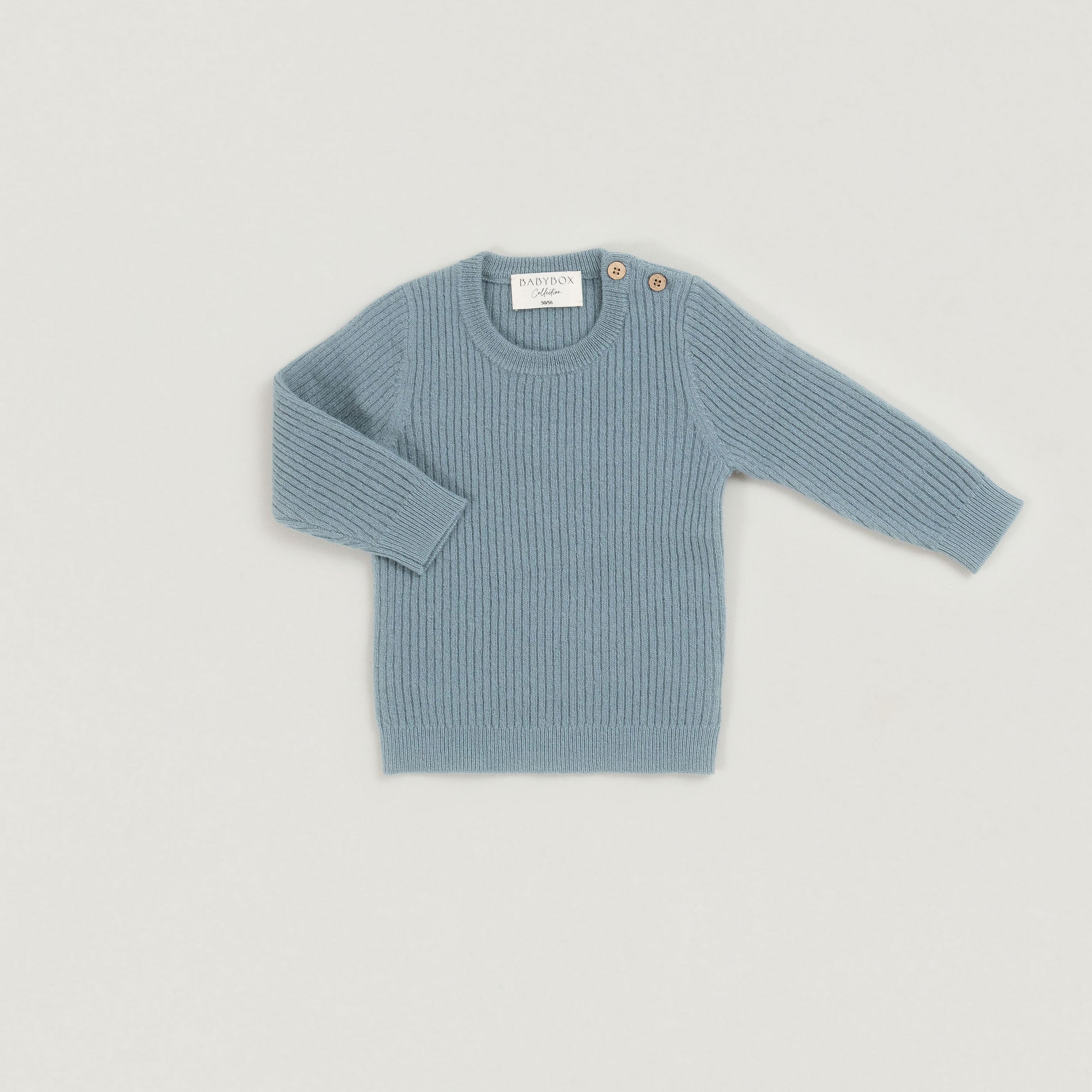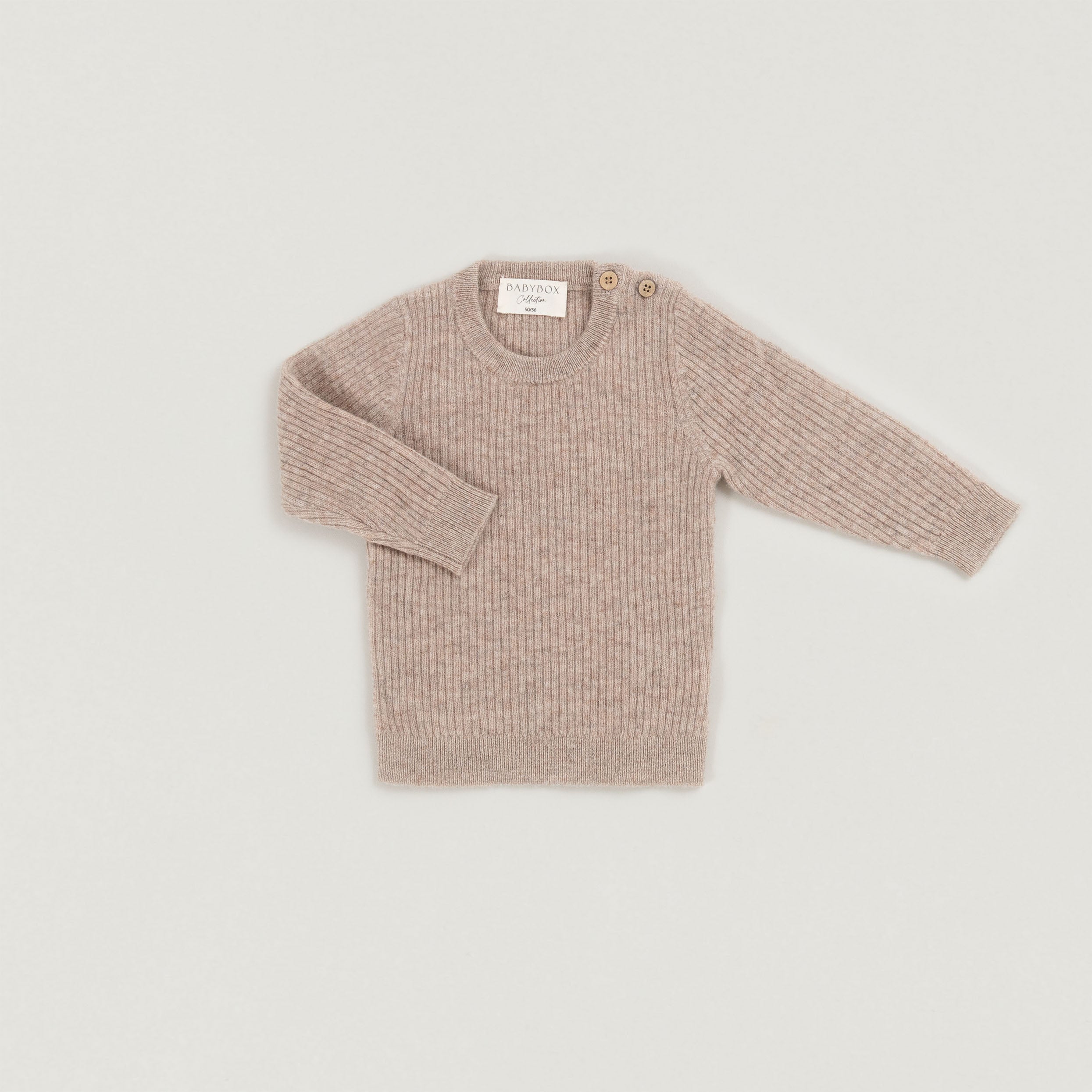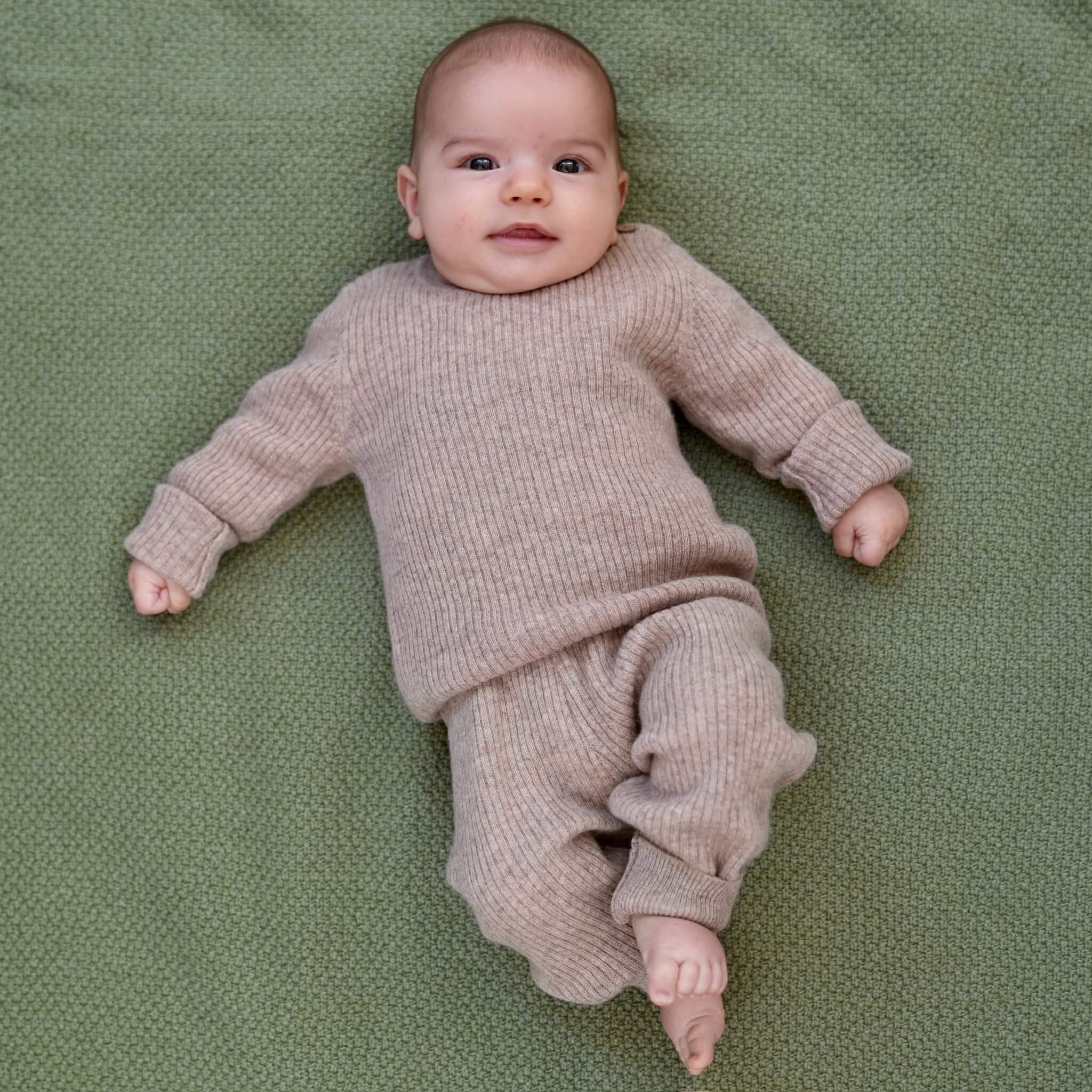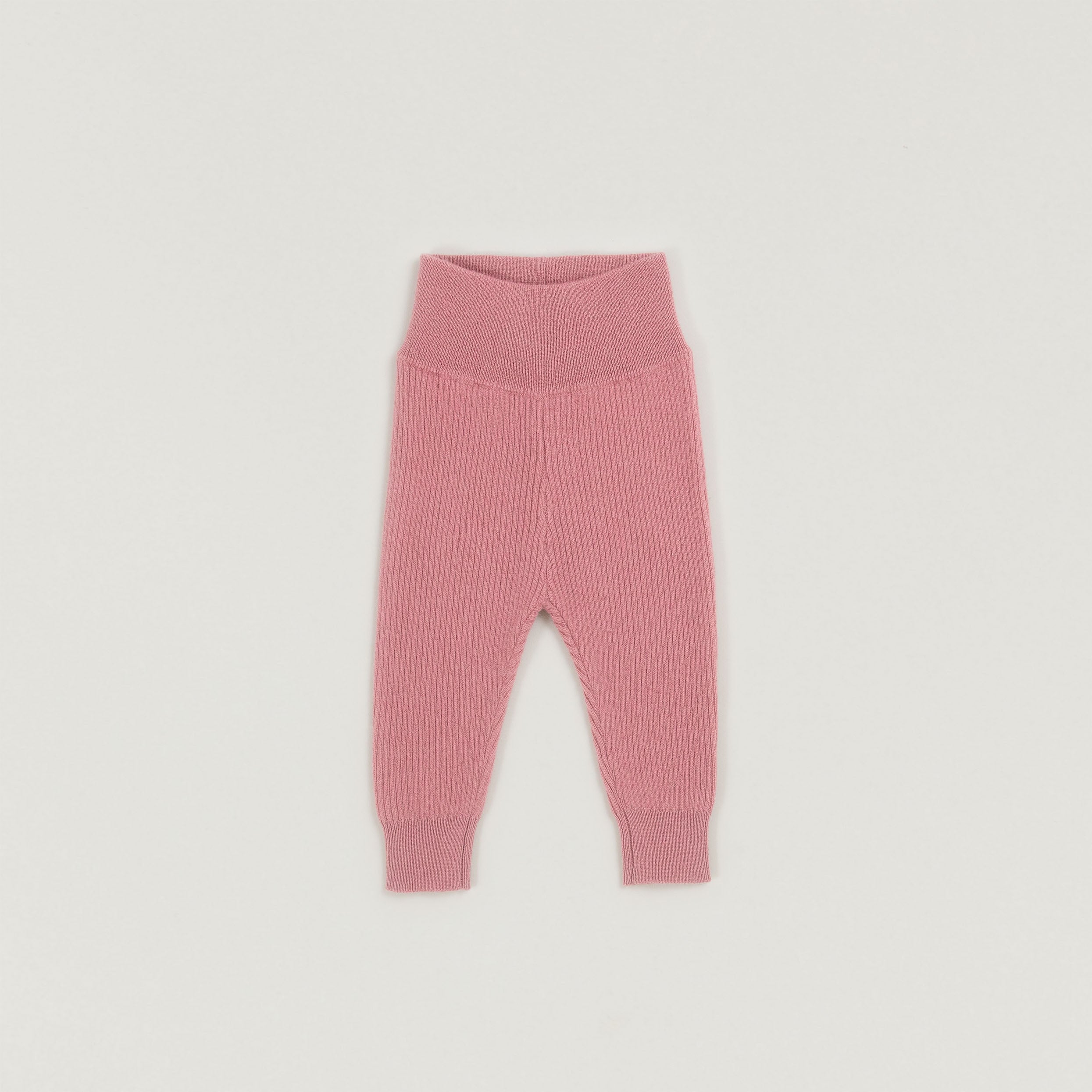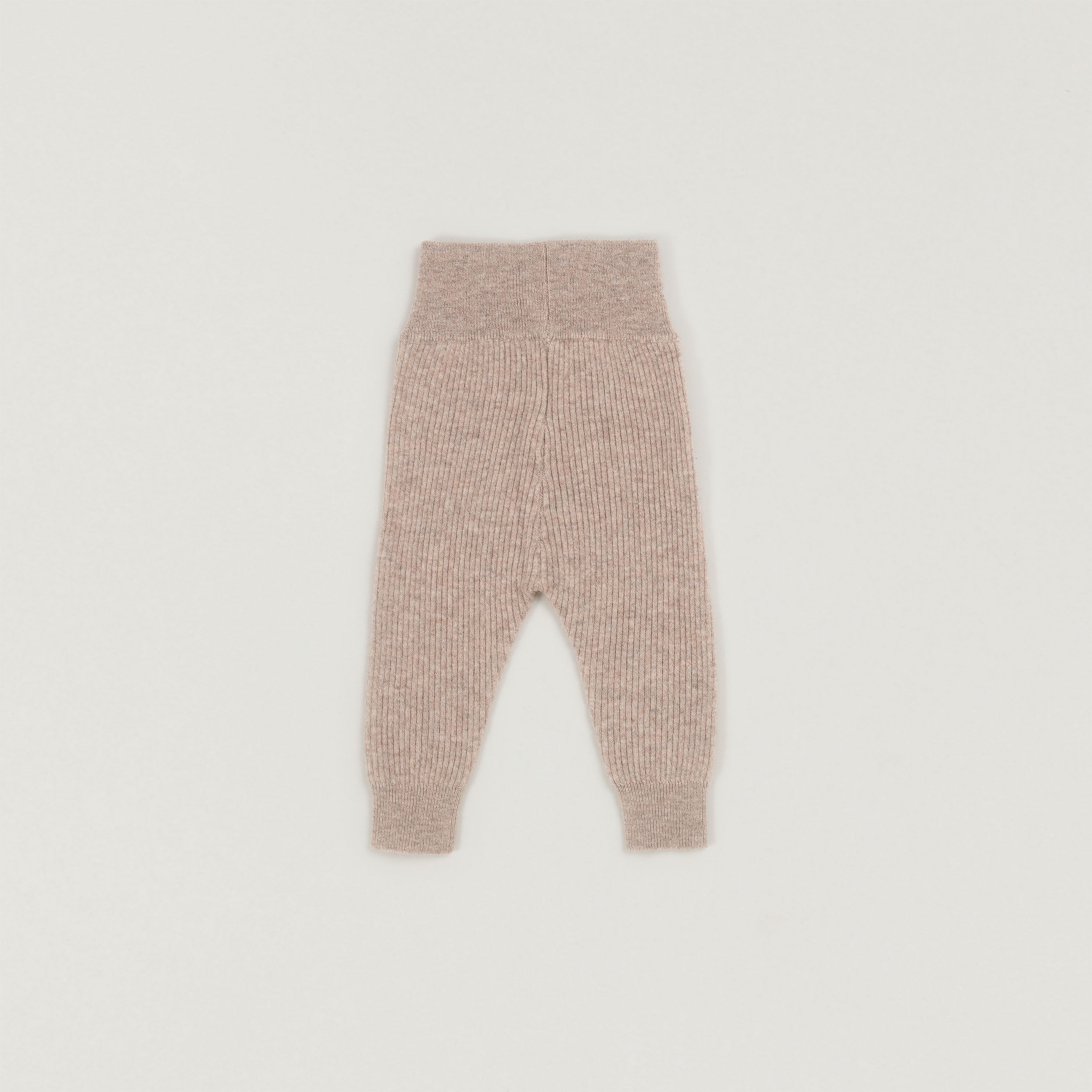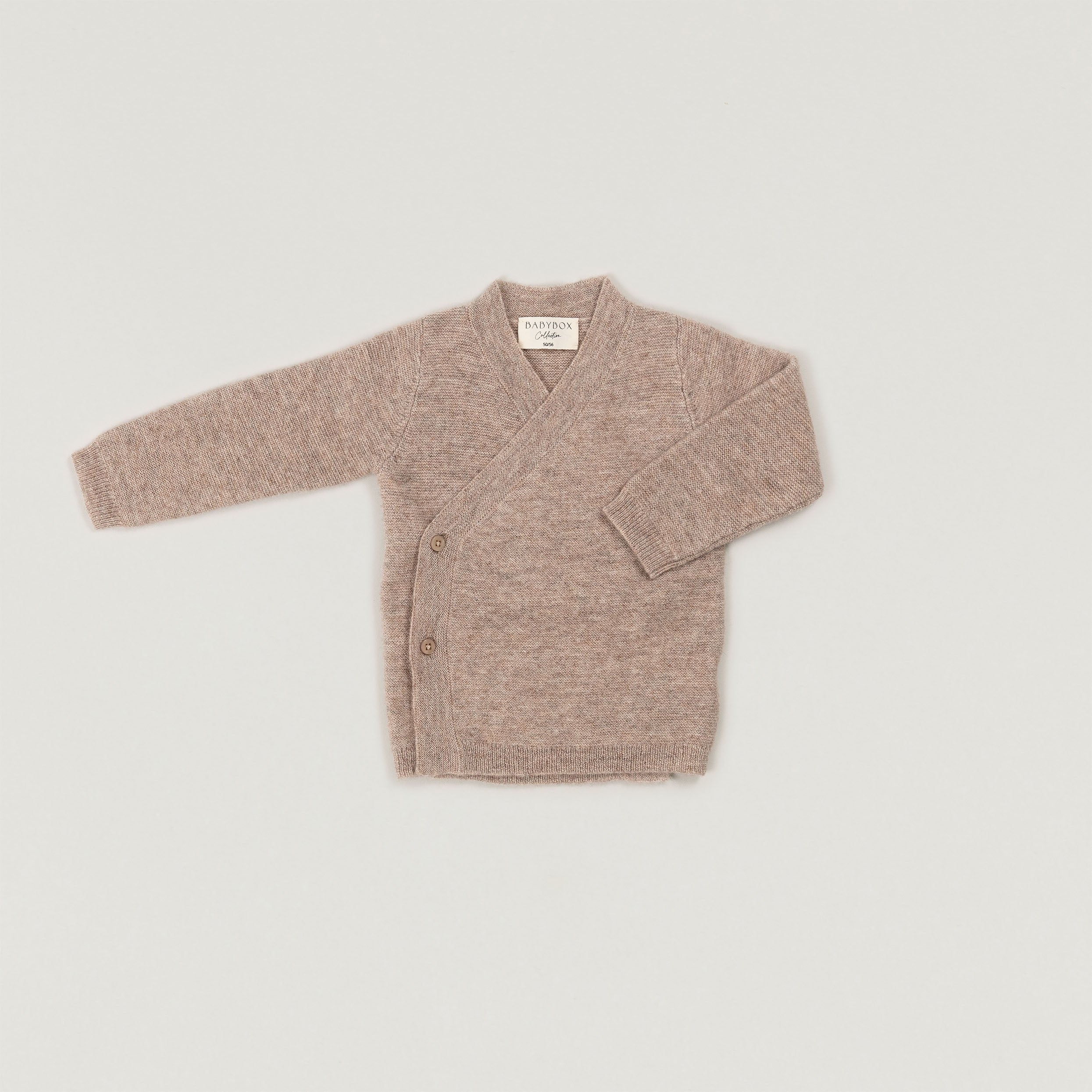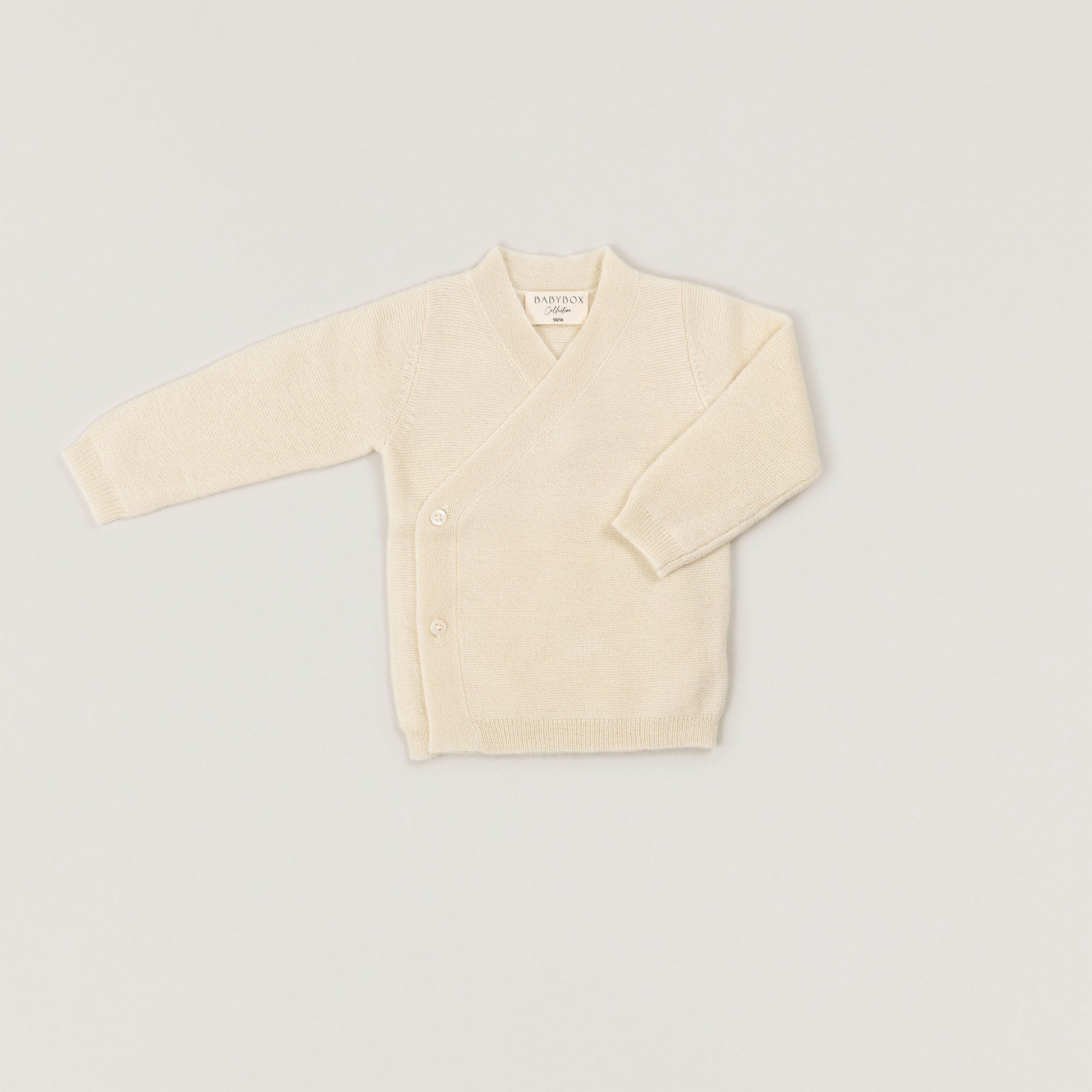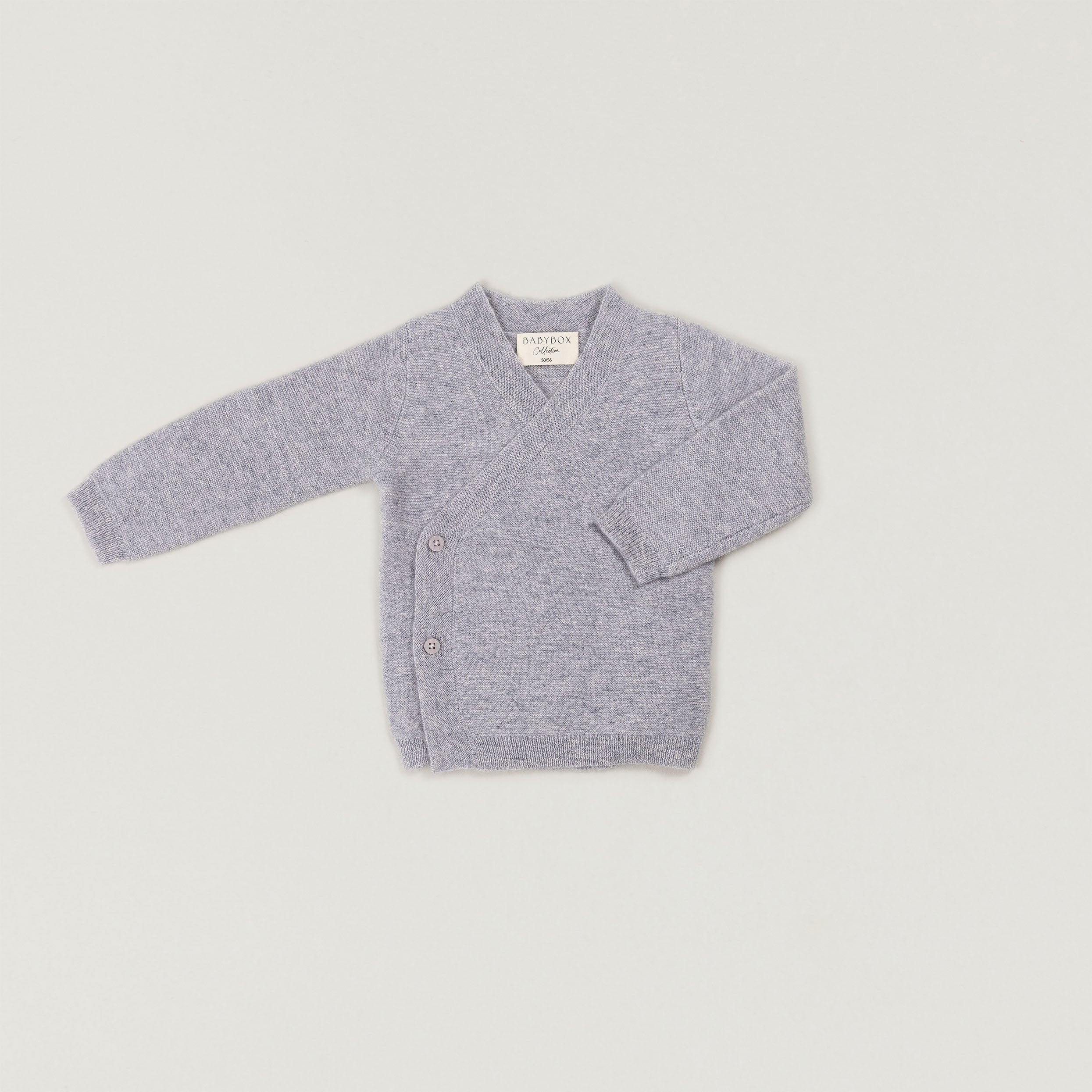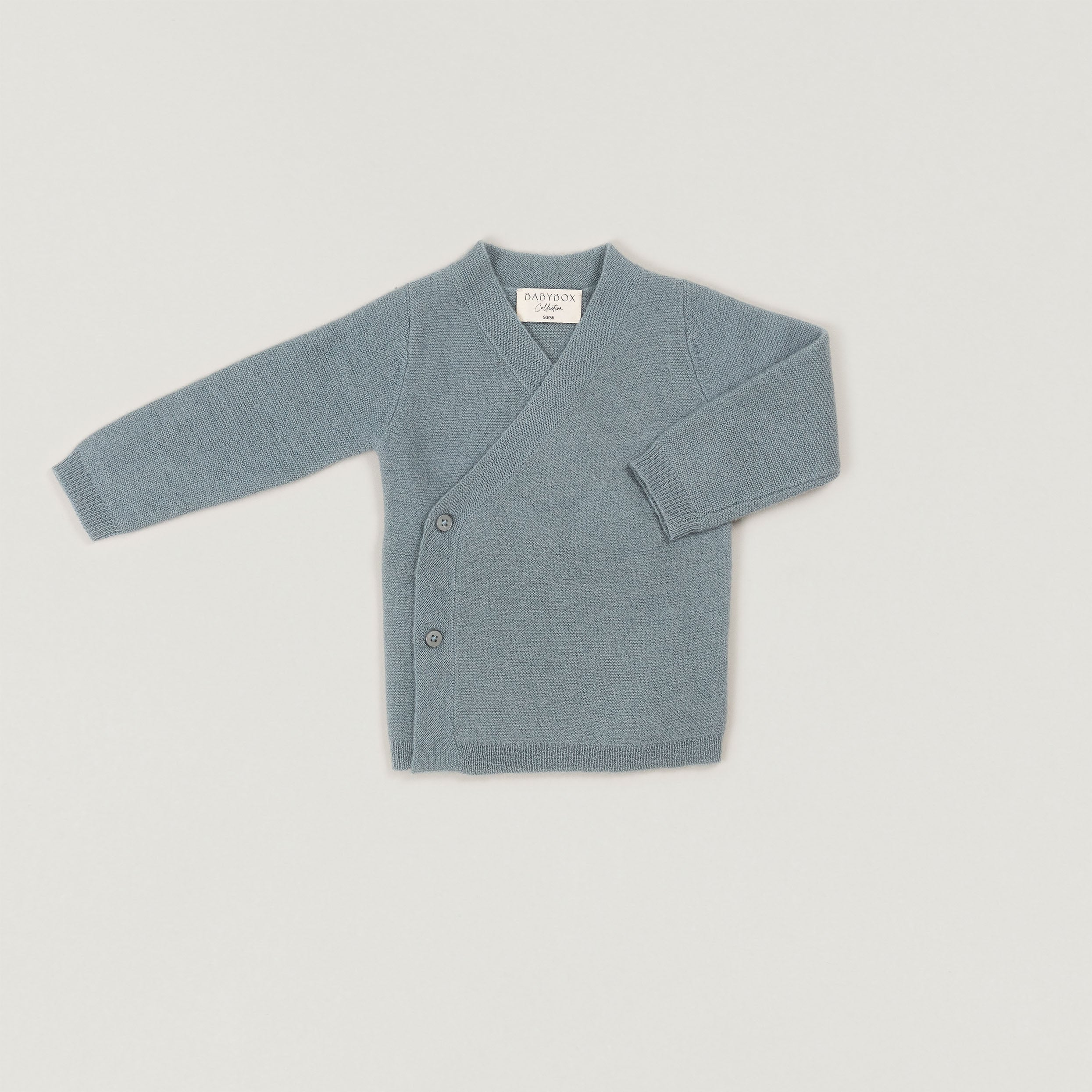Material Care
Clothing should form a protective shell for newborn babies. The choice of material affects their comfort. Can they feel moisture when something leaks? Does it scratch or itch anywhere, possibly because bacteria accumulate due to sweating?
Here are our care tips for different materials. Important note: If the fabric is a blend, such as wool & silk, always follow the care instructions for the more sensitive material, and if both are sensitive, then choose the material that has the highest proportion.
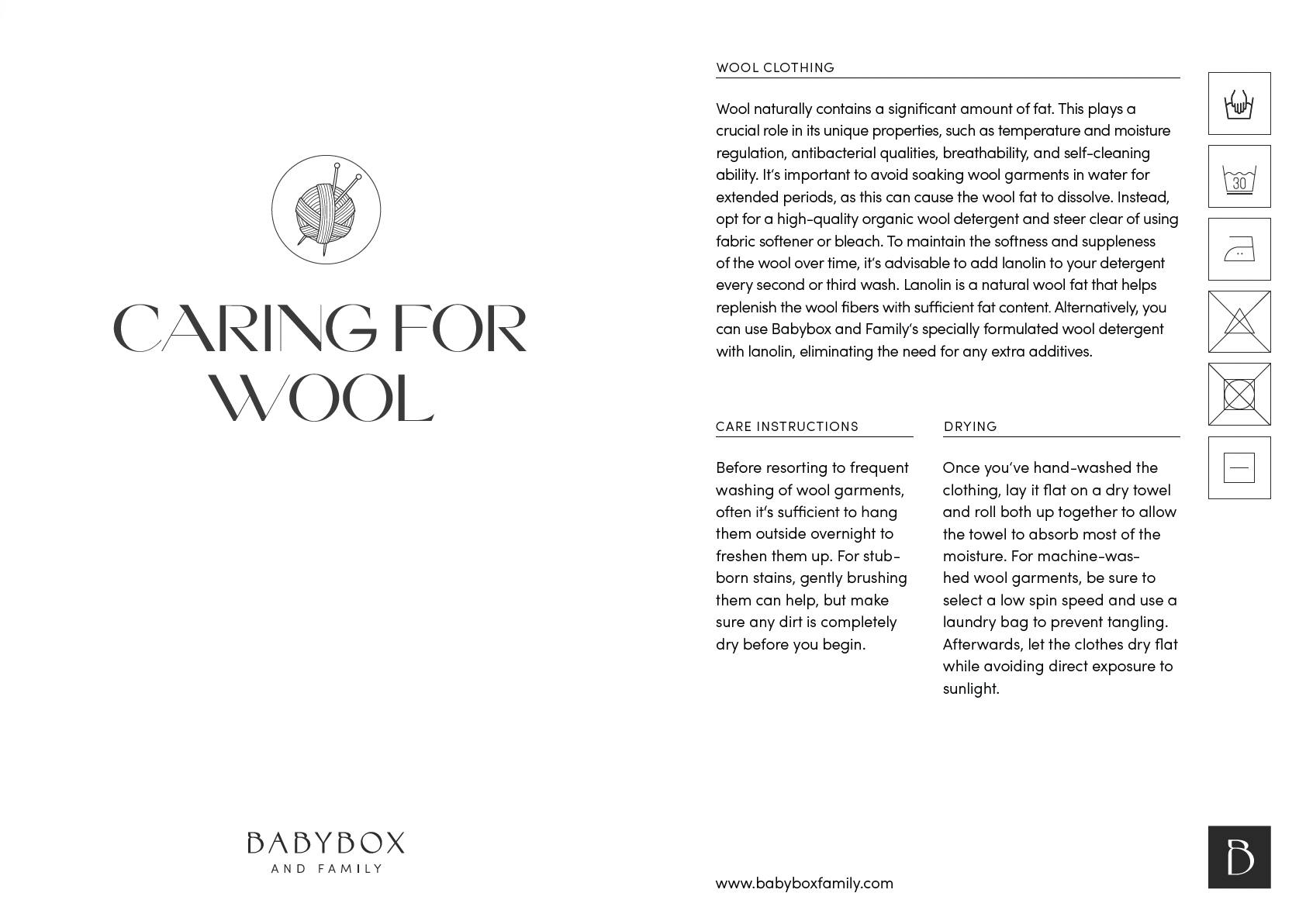
Our recommendation: Always read the care instructions on the respective garments. The specific composition of the manufacturer and the origin of the materials often require individual care.
Proper care for Merino wool and new wool:
- Wool textiles do not get dirty as quickly as cotton textiles because the natural lanolin content (i.e., the wool fat on the wool fiber) repels dirt. Usually, it is enough to air out the textiles and only wash them when they are truly dirty.
- Wash wool (Merino wool, lambswool, or wool blends) best in cold water, below 30°C, in the washing machine on the wool cycle or by hand. A tip for the washing machine: use a laundry bag to prevent friction against the drum and thus reduce the risk of felting.
- Hand washing: When hand washing, always make sure not to leave the laundry in the water for too long, as it will lose its wool fat and dry out or become brittle. Additionally, avoid wringing or rubbing as this can damage and felt the wool fibers.
- Use a good organic wool detergent to properly protect the fibers. We recommend using a detergent with lanolin, as it will return enough wool fat to the laundry with each wash, so you don't have to worry about when and how much lanolin to add.
- Spinning: Always ensure that the spin speed is not too high during the wool cycle.
- Drying: Let wool clothing dry flat and in the fresh air. For hand washing, we recommend laying the laundry on a dry towel and then carefully rolling it up to remove most of the moisture. After that, let the laundry dry flat.
- Sun exposure/heating: Avoid direct sunlight when drying. This will dry out the wool fibers and make them porous and scratchy.
You can find more important information and tips on how to properly care for wool clothing in our magazine article "How to Properly Wash Wool".
Download washing instructionsWool & Silk is an almost magical material that is the best combines properties of both raw materials. Just at Baby clothing, it is a well-known and popular fabric, but also in the wool & silk clothing is becoming more and more popular in sports and outdoor areas coming.
Before you actually wash cashmere, remember that it has self-cleaning properties. You can hang your favorite item out in the fresh air if there is an odor, for example, or hang it up in the bathroom while you're showering. The high humidity helps!
Even with stubborn individual stains, you don't have to wash the item completely right away.
Our tip: Gently work on the individual stains with soapwort and lukewarm water (!).
The following applies to hand washing: Please never leave your part in the water for long, but make sure that it takes effect for a short time. Never wring out the clothes! (It's better to press them gently between hand and sink.)
Cashmere can usually be washed well with a fine wool detergent by hand or on a hand wash program. (Please always check the washing label for the ideal temperature, but the absolute maximum is 30 degrees). Turn your pieces inside out beforehand to avoid fading and rubbing. It is important that you set a low spin speed (600-800 revolutions) for the washing program and also check the revolutions beforehand for the wool washing program.
Danger! The wet clothing should then always be dried lying flat and pulled into shape! Lay them on a towel or your drying rack, for example. It is normal for small pilling to appear after a while. This is a natural process due to the wear and tear. If the pilling still bothers you, you can pluck it off gently after washing or remove it very carefully with a cashmere comb or cashmere razor. So that your favorite pieces don't stretch or take on completely different shapes, you should of course keep them neatly folded - and not hanging - in the closet.
Moth protection :
Lavender bags, parasitic wasps and cedar wood help against moths! If you want to put the clothes aside longer (e.g. for siblings), consider whether you want to vacuum the parts or not. There are pros and cons. Any pressure caused by vacuuming is harmful to the fibers. However, no moths can get to it when vacuumed. Maybe an airtight box is a good alternative. Decide for yourself!
The Best Care for Bamboo Clothing:
- Washing: Bamboo clothing should be washed in cold or warm water, preferably at 30 degrees Celsius or lower. Avoid hot water as it can damage the fibers. Use a mild, eco-friendly detergent without harsh chemicals or bleach.
- Wash Cycle: Choose a gentle wash cycle that treats the clothing delicately, such as the delicate cycle. Avoid overly long or intense wash cycles to prevent excessive wear.
- Separate Washing: Ideally, wash bamboo clothing separately or with similar colors to prevent discoloration.
- Avoid Fabric Softener: Do not use fabric softener as it can damage bamboo fibers. The natural softness of bamboo fibers should be sufficient.
- Gentle Spin: Set the spin function to low revolutions to put less strain on the clothing.
- Drying: Bamboo clothing can be air-dried to prolong the life of the fibers. If you use a dryer, select a low temperature and a gentle cycle. Remove the clothing from the dryer as soon as it's dry to prevent wrinkles.
- Ironing: Bamboo fibers are naturally wrinkle-resistant, but if you want to iron, use a low ironing temperature. Place a cotton cloth between the iron and the clothing to avoid direct contact.
- Stain Removal: Treat stains immediately with a gentle stain remover to prevent them from setting.
By following these care tips, you can ensure that your bamboo clothing remains beautiful and comfortable to wear for a long time.
Caring for linen clothing requires special attention to maintain the quality and lifespan of the pieces. Here are the best care instructions for linen clothing:
- Washing:
- Linen should be washed in cold or lukewarm water (around 30°C) using a mild detergent.
- It is advisable to wash linen separately or with similar colors as it can tend to bleed color.
- Avoid excessive scrubbing or rubbing while washing, as this can damage the fabric.
- Hand washing is a gentler method, but you can also machine wash linen using a gentle cycle.
2. Drying:
- Linen should be air-dried, preferably in the shade or indoors to avoid direct sunlight.
- Avoid using a tumble dryer, as it can stress linen fibers and may cause the clothing to shrink.
3. Ironing:
- Iron linen clothing while it is still slightly damp to remove wrinkles. Use a medium to high-temperature setting.
- For an especially smooth look, you can use steam. Consider using an ironing cloth to protect the fabric.
4. Storage:
- Store linen in a dry place to prevent mold growth.
- Avoid hanging linen clothing on hangers for extended periods, as it may cause stretching. Instead, fold it and lay it flat in your wardrobe.
5. Stain Removal:
Treat stains as soon as possible. Use a mild detergent or gall soap and gently dab the stain instead of rubbing.
6. Unique Characteristics:
- Linen may tend to stiffen slightly after each wash but will become softer with wear and time.
- The wrinkles that occur in linen clothing are a characteristic feature and contribute to its relaxed look. You can embrace them or iron to smooth them out.
By following these care instructions, you can ensure that your linen clothing remains in good condition and feels comfortable for a long time.
The great thing about cotton and silk is that it combines the advantages of both materials: the durability of cotton with the softness and antibacterial properties of silk. However, because the fabrics are mixed, they require more gentle care than pure cotton, so you can be sure that the products will retain their properties for a long time and protect your baby's sensitive skin.
Please always read the care instructions on the garments themselves carefully. Depending on the manufacturing company, the origin and composition of the materials varies and may require treatment that differs from these care instructions.
Use a laundry bag for your wool and silk clothing. This will prevent the laundry from rubbing against the washing machine drum and protect your clothing.
Always use the gentle cycle and make sure that the machine uses water that is as cold as possible (max. 30 °C) .
Reduce the spin speed to max. 600 rpm and make sure that no final spin is set. Or: squeeze your laundry gently by hand without twisting the fabric. This way you can skip the spin cycle altogether.
Use a high-quality, organic detergent and follow the manufacturer's instructions on usage and dosage. We recommend the wool shampoo from Disana . It is particularly mild and ideal for all natural products.
You can carefully treat stains on your cotton and silk products with gall soap and then add them to the laundry.
Dry your cotton & silk laundry lying on a towel and carefully pull it into shape after washing. Hanging it up can stretch the fibers. Please never let it dry in the blazing sun, in the dryer or on the heater . The best way to achieve good ventilation is to dry it in the fresh air.
If absolutely necessary, iron only at the lowest temperature setting .
Turn the garment inside out and use a thin cloth between the iron and the fabric to avoid shiny spots. Also, avoid steam as silk can be sensitive to moisture.
Lanolin is a secretion that is produced in the sebaceous glands of sheep and gives wool its properties (stain and odor repellent as well as heat regulation). The lanolin in our detergent is obtained from wool production. The sheared wool is washed for further processing and specifically in preparation for dyeing to remove the wool fat from the wool so that it can absorb dye. Lanolin, also known as wool fat, is extracted from the remaining washing suds using a low-pollutant solvent.
Why should you use lanolin when washing woolen clothes?
With each wash, the wool loses its own fat, which makes the wool soft and supple. By losing the wool fat, the wool also loses its properties (stain and odor repellent as well as heat regulation) and it is therefore important that you add lanolin/wool fat to the wool every 2-3 washes so that the clothes remain durable and supple.
How do I know that the wool no longer has any wool grease?
Wool and also wool & silk clothing that has little or no wool fat feels hard and brittle. Unfortunately, it is almost impossible to completely re-grease a wool that has been fully washed out. Therefore, you should use lanolin every 2-3 washes to prevent this.
Pilling bezeichnet die Bildung kleiner Fusselbällchen oder Knötchen auf der Oberfläche von Textilien. Dieses entsteht durch Reibung, zum Beispiel beim Tragen, Waschen oder Abrieb. Dabei lösen sich einzelne Fasern aus dem Gewebe, verklumpen miteinander und bilden so die typischen "Pills".
Die Pillingneigung hängt weniger nur von der Wollsorte an sich ab als von den Fasereigenschaften und der Verarbeitung. Grundsätzlich gilt:
- Kurze Fasern pillen stärker: Wolle, die aus kürzeren Fasern besteht – wie sie oft bei Schurwolle von älteren Schafen vorkommt – ist anfälliger für Pilling als langstapelige, feine Wolle (etwa Merinowolle).
- Verarbeitungsweise: Auch die Art, wie die Wolle verarbeitet wird, spielt eine Rolle. Locker gesponnene oder „wollige“ Gewebe neigen eher zum Pilling, während dichter gesponnene Stoffe (wie bei einem Worsted-Verfahren) weniger dazu tendieren.
- Mischungen: Beim Einsatz von Wollmischungen, etwa mit synthetischen Fasern, kann sich die Pillingneigung zusätzlich erhöhen.
Kurz gesagt: Reine Schurwolle aus älteren Schafen (mit kürzeren Fasern) und locker verarbeitete Wollstoffe pillen in der Regel am stärksten.
Pilling ist kein Anzeichen von schlechter Qualität - ganz im Gegenteil. Und es ist völlig normal.
Um Pilling zu reduzieren bietet es sich an, einen speziellen Kamm zu verwenden. Bei sehr groben Pilling kann auch vorsichtig ein Fusselrasierer verwendet werden.
Tip
How to care for and wash wool properly
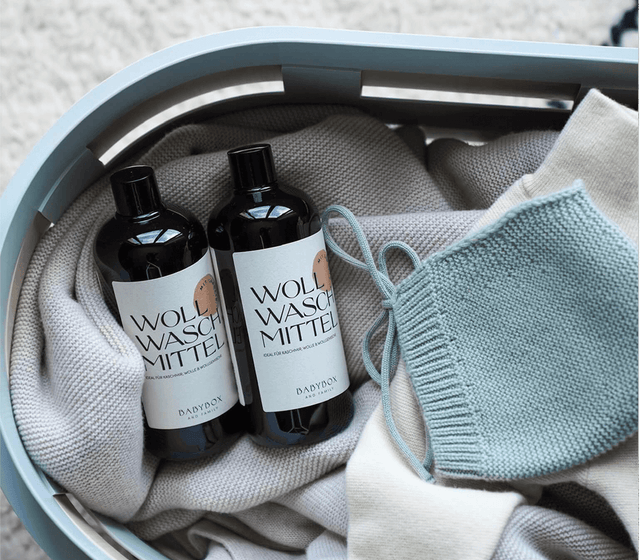
Wool is a natural fiber made of keratin that is warm, breathable, elastic and dirt-repellent. These properties make it particularly suitable for sensitive baby and child skin. To protect the wool fiber, you should use cold to lukewarm water and a mild wool detergent when washing. Wash wool gently by hand or on the wool cycle, squeeze it carefully (do not wring) and let it dry flat on a towel. Due to its natural properties, wool does not need to be washed frequently.
Pilling
Warum pillen Wollprodukte?

Bei Pilling handelt es sich um einen natürlichen Verschleißprozess, der insbesondere bei Textilien wie Wolle, Baumwolle oder synthetischen Stoffen auftritt. Doch was genau ist Pilling, wie entsteht es und wie könnt ihr damit umgehen?

 Shop All
Shop All Bodys
Bodys Tops
Tops Pyjamas
Pyjamas Pants | Rompers & More
Pants | Rompers & More Tights | Socks
Tights | Socks Blankets | Sleeping Bags
Blankets | Sleeping Bags Jackets | Overalls
Jackets | Overalls Hats & More
Hats & More Baby Essentials
Baby Essentials Shoes
Shoes Furniture & Nursery Essentials
Furniture & Nursery Essentials Product Care
Product Care New In
New In Shop All
Shop All Mom Gift Boxes
Mom Gift Boxes Babyboxes & Mom Gift Boxes
Babyboxes & Mom Gift Boxes Gift Vouchers
Gift Vouchers Basic Deal
Basic Deal
